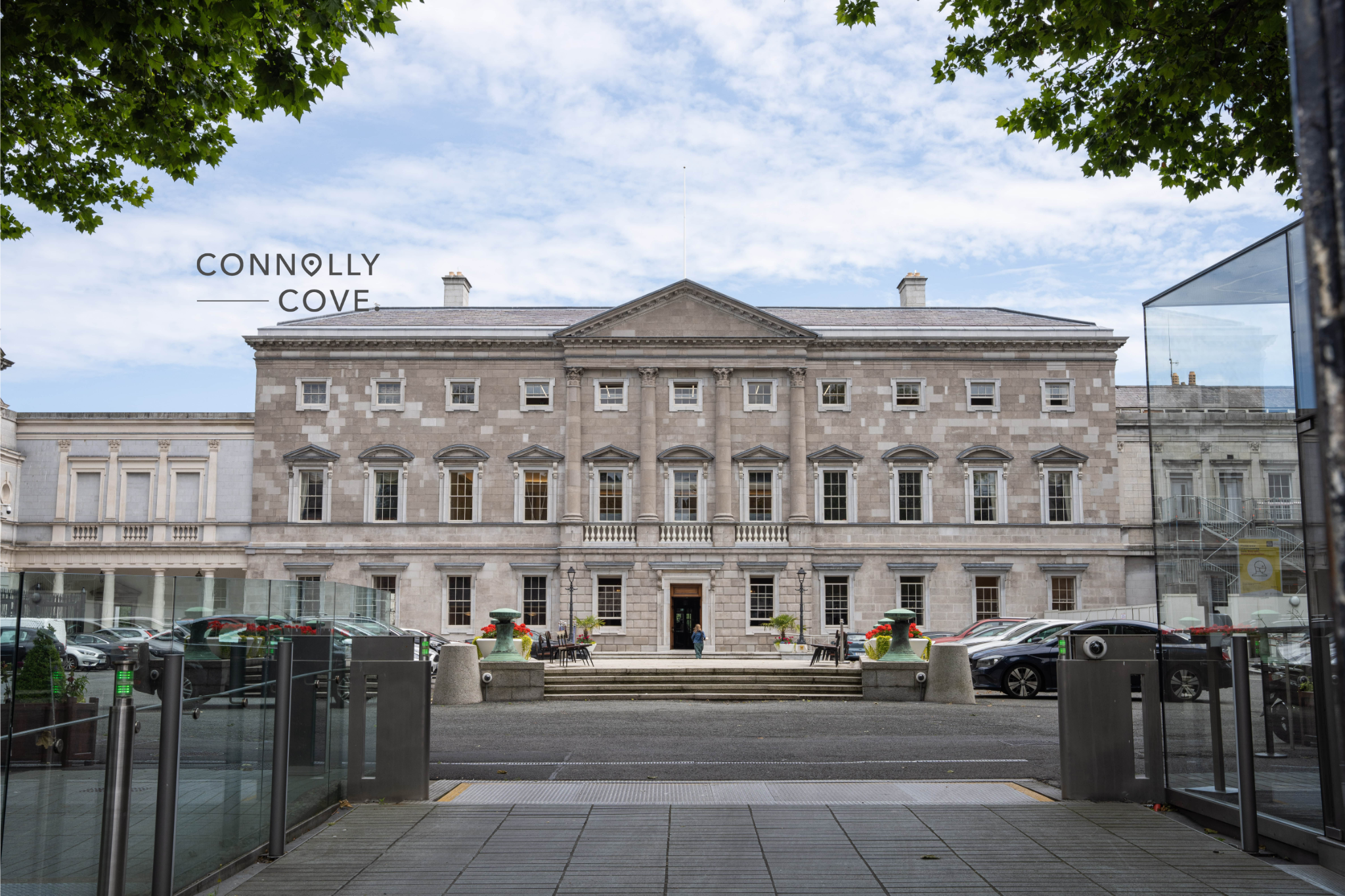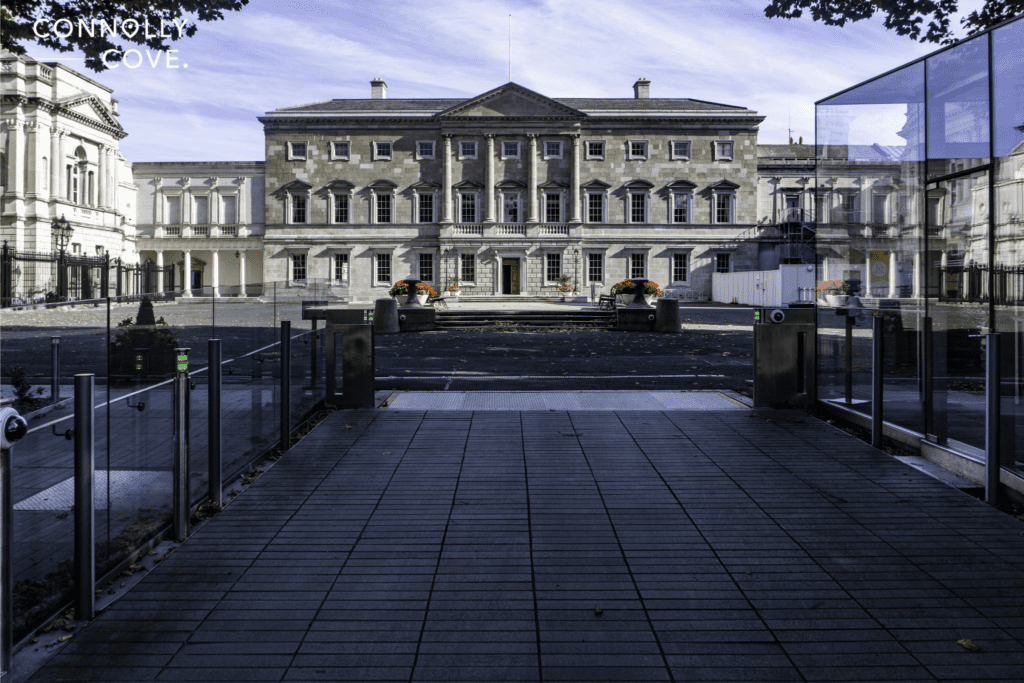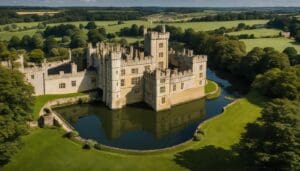Leinster House, Dublin, Ireland

Updated On: April 22, 2024 by Ciaran Connolly
Situated majestically on Kildare Street in Dublin, Ireland, Leinster House is an emblem of political prowess and historical significance. With its elegant Georgian architecture and rich history, Leinster House serves as the seat of the Oireachtas, the Irish Parliament, housing both the Dáil Éireann (House of Representatives) and the Seanad Éireann (Senate). Its halls echo the debates and decisions that have shaped Irish history since its establishment. Let’s delve into the intricate tapestry of Leinster House, tracing its origins, architectural grandeur, and enduring legacy in the Irish political landscape.
Origins and History of Leinster House
Leinster House finds its roots deeply embedded in the annals of Irish history, dating back to the 18th century. Originally known as Kildare House, it was built between 1745 and 1748 by James FitzGerald, the Earl of Kildare, and designed by the renowned architect Richard Cassels. The house served as the private residence of the FitzGerald family until 1815, when it was sold to the Royal Dublin Society (RDS).
In 1922, following the establishment of the Irish Free State, the government required a suitable location for its parliamentary operations. Leinster House was identified as the ideal site, and extensive renovations were undertaken to transform it into a parliamentary complex. The inaugural meeting of Dáil Éireann was convened in the Mansion House on 21 January 1919, but it was not until 1922 that Leinster House became the permanent seat of the Irish Parliament.
Elegance Through the Ages
One cannot help but marvel at the architectural grandeur of Leinster House. The building boasts a symmetrical façade adorned with classical elements reflecting the elegance of Georgian design. Its imposing entrance is flanked by Doric columns, exuding a sense of grandiosity and permanence.
The interior of Leinster House is equally impressive, with ornate plasterwork, stately staircases, and elaborate furnishings that harken back to a bygone era of luxury. The debating chambers of the Dáil and the Seanad are steeped in history, their walls echoing with the impassioned speeches of Ireland’s most esteemed statesmen and women.
Function and Governance

As the seat of the Oireachtas, Leinster House plays a pivotal role in the governance of Ireland. The Dáil Éireann, comprising 160 members elected by proportional representation, convenes in the Chamber of the Dáil to debate legislation, scrutinize government policies, and represent the interests of the Irish people. The Taoiseach (Prime Minister) and members of the Cabinet also hold office within Leinster House, shaping the course of the nation’s affairs.
The Seanad Éireann, on the other hand, provides a forum for intellectual discourse and expertise, with its members drawn from various sectors of society, including academia, culture, and industry. While its powers are more limited than the Dáil’s, the Seanad nevertheless plays a crucial role in the legislative process, offering valuable insights and perspectives on proposed legislation.
Cultural Significance
Beyond its political function, Leinster House holds immense cultural significance for the people of Ireland. It stands as a symbol of democracy and freedom, embodying the aspirations and struggles of generations past. Visitors to Leinster House can partake in guided tours, exploring its hallowed halls and gaining insight into the workings of Irish democracy.
Moreover, Leinster House serves as a venue for cultural events, receptions, and exhibitions, showcasing the rich tapestry of Irish arts and heritage. From literary readings to musical performances, the building buzzes with activity, fostering community and camaraderie among its occupants and visitors.
Challenges and Renewal
While Leinster House remains a beacon of Irish political heritage, it has not been immune to the challenges of modernity. The ageing infrastructure and limited space pose logistical hurdles for parliamentarians and staff. In recent years, there have been calls for extensive renovations and modernization efforts to ensure that Leinster House can continue to serve as a functional and dignified seat of government.
Plans for the redevelopment of Leinster House have been put forth, aiming to preserve its historic character while enhancing its functionality and accessibility. These proposals include constructing additional office space, implementing sustainable design principles, and incorporating modern technology to facilitate remote participation in parliamentary proceedings.
Visiting Leinster House
For those interested in experiencing the rich history and grandeur of Leinster House firsthand, guided tours are available to the public. Visitors can explore the building’s majestic interiors, learn about its fascinating past, and gain insight into the workings of the Irish parliament.
During the tour, knowledgeable guides provide commentary on the building’s architecture, its historical significance, and the inner workings of the Oireachtas. Visitors can visit the Dáil Chamber, the Seanad Chamber, and other critical areas of interest, gaining a deeper understanding of Ireland’s political system and democratic principles.
Exploring Nearby Attractions Around Leinster House
While Leinster House is a captivating destination, visitors to Dublin will find various attractions nearby that complement their experience. From historic landmarks to cultural institutions, the area surrounding Leinster House offers something for everyone to enjoy. Here are some notable attractions worth exploring:
1. National Museum of Ireland – Archaeology: Located just a short walk from Leinster House, the National Museum of Ireland – Archaeology is a treasure trove of Ireland’s ancient past. Visitors can marvel at the museum’s extensive collection of artefacts, including the renowned Ardagh Chalice, Tara Brooch, and the preserved bog bodies. The museum provides fascinating insights into Ireland’s prehistoric and medieval civilizations.
2. Trinity College Dublin: One of Ireland’s oldest and most prestigious universities, Trinity College Dublin is a must-visit for history buffs and culture enthusiasts. The campus is nearby and boasts architectural gems such as the iconic Campanile and the stunning Long Room of the Old Library, home to the world-famous Book of Kells. Visitors can stroll through the cobblestone paths of the college and immerse themselves in centuries of academic tradition.
3. National Gallery of Ireland: Art lovers will delight in the National Gallery of Ireland, located within walking distance of Leinster House. The gallery houses an impressive collection of Irish and European art spanning centuries of artistic achievement. The gallery offers a captivating journey through art, from masterpieces by renowned painters such as Caravaggio and Vermeer to works by prominent Irish artists like Jack B. Yeats.
4. Merrion Square: A tranquil oasis in the heart of Dublin, Merrion Square is a picturesque Georgian park that offers respite from the bustling city streets. Visitors can wander through the lush greenery, admire the colourful flowerbeds, and marvel at the statues of prominent figures such as Oscar Wilde and William Butler Yeats. On weekends, the park comes alive with a vibrant open-air market showcasing local artisans and food vendors.
5. Grafton Street: For shopping and entertainment, Grafton Street is a vibrant thoroughfare located within easy reach of Leinster House. Lined with an eclectic mix of shops, cafes, and street performers, this bustling pedestrianized street offers endless opportunities for strolls and people-watching. Visitors can browse for souvenirs, enjoy live music performances, or simply soak in the lively atmosphere.
6. Dublin Castle: Steeped in history and grandeur, Dublin Castle is a short distance from Leinster House and offers a glimpse into Ireland’s medieval past. Visitors can explore the castle’s opulent State Apartments, stroll through the beautifully landscaped gardens, and learn about its role as a seat of British power in Ireland. Guided tours provide insight into the castle’s rich heritage and architectural significance.
7. St. Stephen’s Green: Another green oasis in Dublin’s city centre, St. Stephen’s Green is a tranquil haven for nature lovers and outdoor enthusiasts. Visitors can unwind amidst the park’s lush lawns, serene ponds, and vibrant floral displays. The park also features statues, monuments, and memorials commemorating Ireland’s history and cultural heritage, making it an ideal spot for a leisurely afternoon stroll.
The Ideal Time to Experience Dublin’s Charms
Dublin beckons visitors year-round with its vibrant culture, rich history, and welcoming atmosphere. However, the best time to experience the city’s charms is during the mild months of late spring to early autumn, typically from May to September.
During this time, Dublin enjoys pleasant weather, with temperatures ranging from comfortable to warm, making it perfect for exploring the city’s outdoor attractions, such as parks, gardens, and historic sites. Moreover, this period coincides with numerous festivals and events, including the renowned St. Patrick’s Festival in March and the Dublin Fringe Festival in September, offering visitors a taste of the city’s lively arts and cultural scene. Whether wandering through the cobbled streets of Temple Bar, savouring a pint of Guinness in a cosy pub, or taking a stroll along the River Liffey, the summer months provide an ideal backdrop for immersing oneself in Dublin’s vibrant ambience and embracing the warmth of Irish hospitality.
Conclusion
Leinster House stands as a testament to the enduring legacy of Irish democracy. From its humble origins as a private residence to its current status as the seat of the Oireachtas, it has borne witness to the triumphs and tribulations of the Irish nation. Its architectural splendour, political significance, and cultural resonance make it a cherished institution revered by citizens and leaders alike.
As Ireland continues to navigate the complexities of the 21st century, Leinster House remains steadfast in its commitment to upholding the principles of democracy, accountability, and equality. It serves as a reminder of the power of dialogue and debate in shaping history, inspiring future generations to uphold the values upon which the nation was founded.
In the heart of Dublin, amidst the hustle and bustle of modern life, Leinster House stands as a beacon of hope and inspiration, beckoning all who enter to contribute to the ongoing story of Ireland’s democracy. Long may its halls resound with the voices of the people, echoing through the corridors of power for generations to come.






